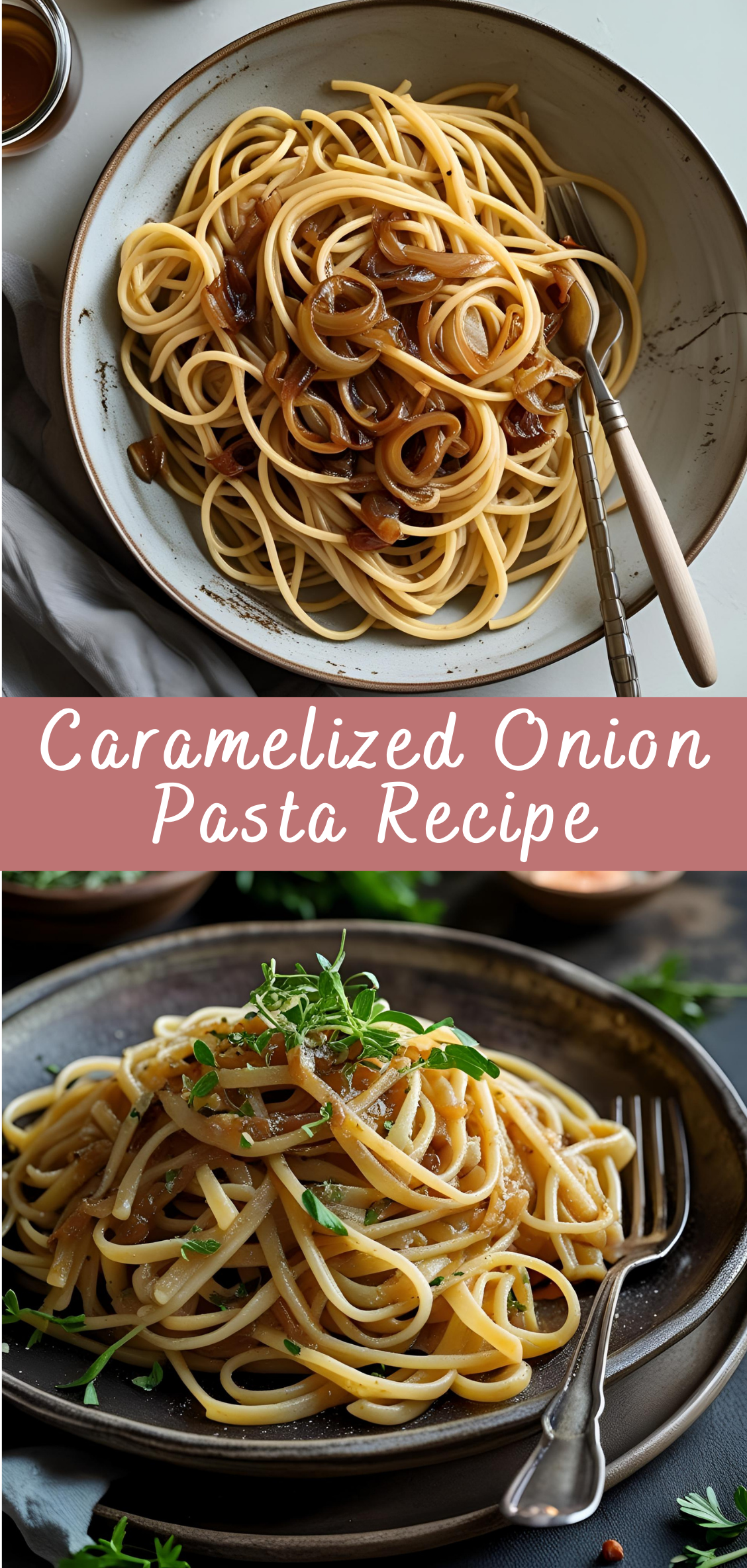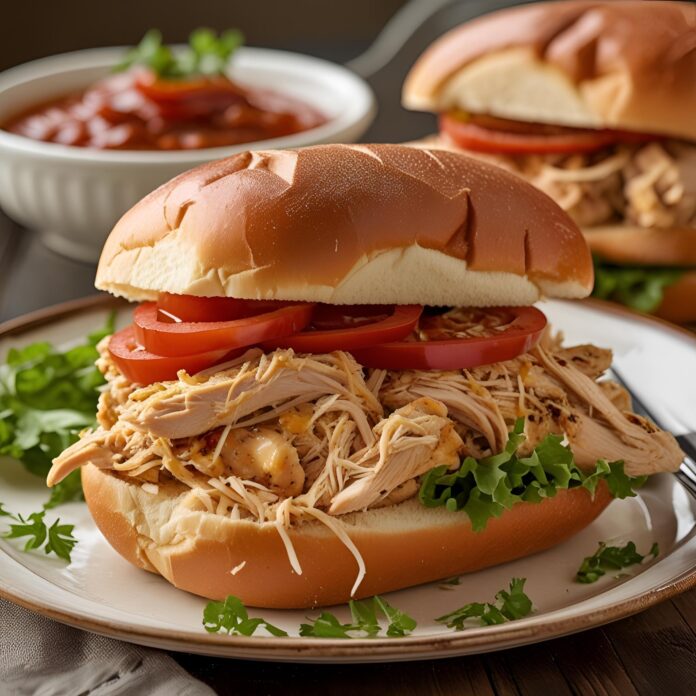Caramelized Onion Pasta Recipe
In a world filled with complex sauces, exotic ingredients, and fast-paced kitchen shortcuts, there’s something deeply satisfying—almost revolutionary—about a dish built on patience. Enter Caramelized Onion Pasta: a recipe that proves how a handful of simple, everyday ingredients can transform into something unexpectedly luxurious when treated with care, attention, and time.

At its heart, this is a dish that relies on a single central ingredient: onions. Not just any onions tossed into a pan and browned in a rush, but deeply caramelized, slow-cooked onions that have surrendered all their sharpness in exchange for a sweet, jammy richness. It’s a process of transformation that feels alchemical. Over the course of 30 to 45 minutes, the humble onion—often relegated to the background of dishes—steps into the spotlight and becomes the soul of the meal.
Paired with perfectly cooked pasta, a splash of starchy water, a touch of cheese, and maybe a knob of butter or drizzle of olive oil, caramelized onions can carry the entire dish. No meat. No cream. No elaborate preparation. Just layers of savory sweetness, silky strands of pasta, and a deeply satisfying flavor that tastes far more indulgent than it actually is.
Why Caramelized Onion Pasta Works
To appreciate this dish fully, you need to understand what makes it tick. Caramelized onion pasta isn’t flashy. It doesn’t rely on spice or spectacle. It’s the kind of food that comforts you after a long day, nourishes you in a quiet way, and leaves you feeling like you’ve eaten something meaningful.
It works because it embraces a few foundational principles of great cooking:
-
Time equals flavor.
Caramelization isn’t browning. It’s a slow, delicate process that draws out the onion’s natural sugars. Over time, those sugars deepen into complex, roasted-sweet notes that are savory and slightly earthy. -
Contrast and balance.
The sweetness of the onions is balanced by salty pasta water, tangy cheese, and the slight bite of al dente noodles. The richness can be cut with lemon zest, vinegar, or even a pinch of chili flakes. -
Texture is everything.
Caramelized onions become silky, almost jam-like, clinging to each strand of pasta. Add toasted breadcrumbs, crispy shallots, or fresh herbs and you create layers of texture in every bite.
A Dish That Transcends Its Ingredients
It’s worth repeating: this dish requires only a few pantry staples. You likely have everything you need already in your kitchen—onions, pasta, oil or butter, salt, maybe a bit of Parmesan or pecorino. And yet, when executed properly, the finished dish feels refined, elegant, even a bit indulgent.
That’s what makes it such a favorite among home cooks and food lovers alike. It’s frugal but rich. It’s minimal but complete. It fits seamlessly into a weeknight routine but feels equally appropriate as the centerpiece of a cozy dinner with friends.
A Historical Footnote
While caramelized onion pasta has no single, definitive cultural origin, it echoes traditions from many places. In Italian cucina povera, dishes made from simple, inexpensive ingredients are elevated through careful technique. In French cuisine, slow-cooked onions are central to dishes like soupe à l’oignon. Even Persian and Middle Eastern cuisines celebrate deeply cooked onions as the foundation for rice and stews.
This pasta feels like a natural extension of all those traditions: a dish that honors patience, simplicity, and respect for ingredients.
Variations Are Endless
One of the joys of caramelized onion pasta is how easy it is to customize. It can be made vegan, gluten-free, or spiked with rich additions like pancetta, goat cheese, or crispy mushrooms. You can build it into something creamy and luxurious, or keep it austere and plant-based.
Want a bright finish? Add lemon juice or zest. Craving protein? Toss in shredded chicken or seared tofu. Looking for spice? A pinch of chili flakes or black pepper can change the whole profile.
Each variation starts from the same dependable base: beautifully caramelized onions.
Detailed Instructions: How to Make Caramelized Onion Pasta
Step 1: Select and Prepare Your Onions
The foundation of this dish is perfectly caramelized onions. Start with the right onions and prep them correctly.
-
Onion choice: Yellow onions are the most classic and ideal for caramelizing due to their balanced sweetness and mild pungency. Sweet onions (like Vidalia) work well too but can caramelize faster and become very sweet. Red onions add a beautiful color but tend to be sharper.
-
Preparation: Peel the onions and slice them thinly and evenly into half-moons or rings about ⅛ to ¼ inch thick. Uniform slicing ensures even cooking.
Tip: Use a sharp knife or a mandoline for consistent slices to avoid uneven cooking.
Step 2: Heat the Pan and Add Fat
Use a wide, heavy-bottomed skillet or sauté pan—this allows the onions to cook evenly without steaming.
-
Place the pan over medium-low heat.
-
Add 2 to 3 tablespoons of olive oil or unsalted butter (or a combination). Butter adds richness; olive oil lends a cleaner flavor.
-
Let the fat heat until shimmering but not smoking.
Why medium-low?
Low heat is key for caramelization without burning. Patience is essential here: the slow, gentle heat allows natural sugars to develop slowly.
Step 3: Add the Onions and Begin Caramelizing
-
Add the sliced onions to the pan, spreading them out evenly.
-
Stir to coat the onions in the fat.
-
Sprinkle with a pinch of salt (this helps draw out moisture).
Cooking process:
-
Keep the heat low and cook slowly, stirring every 5–7 minutes.
-
After about 10–15 minutes, the onions will become translucent and begin softening.
-
Continue cooking and stirring occasionally for 30 to 45 minutes or until the onions are deeply browned, soft, and jammy.
-
If the onions start sticking or browning too quickly, reduce heat.
-
If they dry out, add a splash of water, broth, or wine to loosen the pan and scrape up any browned bits.
Pro tip: Resist the urge to stir constantly. Letting the onions sit undisturbed for several minutes helps develop that rich, deep color and flavor.
Step 4: Cook the Pasta
While the onions caramelize, prepare your pasta.
-
Bring a large pot of salted water to a boil.
-
Add 8 ounces (about half a pound) of your preferred pasta—spaghetti, linguine, fettuccine, or short shapes like penne or rigatoni all work well.
-
Cook until al dente, following package instructions minus about 1 minute, since pasta will finish cooking in the pan.
-
Before draining, reserve 1 cup of pasta cooking water.
-
Drain the pasta and set aside.
Step 5: Build the Sauce
With your deeply caramelized onions ready, it’s time to transform them into the sauce base.
-
Lower the heat under the onion pan to medium-low.
-
Add a splash (2-3 tablespoons) of pasta cooking water to the onions to deglaze the pan and loosen the caramelized bits.
-
Stir in 1–2 tablespoons of butter or olive oil to enrich the sauce.
-
Optionally, add minced garlic at this stage and cook for 1 minute until fragrant.
Step 6: Combine Pasta and Sauce
-
Add the drained pasta directly to the pan with the onions.
-
Toss vigorously, using tongs or a pasta fork, to coat the noodles with the onion sauce.
-
Add reserved pasta water gradually as needed to loosen the sauce and help it cling to the noodles.
-
Adjust seasoning with salt and freshly cracked black pepper.
-
For brightness and balance, consider adding a squeeze of fresh lemon juice or a pinch of chili flakes.
Step 7: Add Cheese and Final Touches
-
Remove the pan from heat.
-
Stir in freshly grated Parmesan, Pecorino Romano, or your preferred hard cheese.
-
Add a handful of chopped fresh herbs like parsley or thyme for freshness.
-
For extra richness, fold in a small dollop of crème fraîche or mascarpone (optional).
Step 8: Plate and Serve
-
Divide the pasta among warmed plates or bowls.
-
Garnish with extra cheese, herbs, or a drizzle of good olive oil.
-
Serve immediately with crusty bread or a simple green salad.
Caramelized Onion Pasta Recipe
In a world filled with complex sauces, exotic ingredients, and fast-paced kitchen shortcuts, there’s something deeply satisfying—almost revolutionary—about a dish built on patience. Enter Caramelized Onion Pasta: a recipe that proves how a handful of simple, everyday ingredients can transform into something unexpectedly luxurious when treated with care, attention, and time.
Ingredients
- 12 oz (340g) pasta (spaghetti, fettuccine, or your favorite shape)
- 3 large yellow onions, thinly sliced
- 3 tbsp olive oil or unsalted butter (or a mix)
- 2 cloves garlic, minced
- 1/2 tsp salt
- 1/4 tsp black pepper
- 1/2 tsp sugar (optional, helps with caramelization)
- 1/4 cup dry white wine or vegetable broth (optional)
- 1/2 cup grated Parmesan cheese (plus extra for serving)
- 1/4 cup chopped fresh parsley or thyme (optional)
- Red pepper flakes (optional, for a bit of heat)
Instructions
- Cook pasta:
Cook pasta according to package directions until al dente. Reserve 1 cup of pasta water, then drain. - Caramelize onions:
While pasta cooks, heat olive oil or butter in a large skillet over medium-low heat. Add sliced onions, salt, and sugar (if using). - Cook slowly:
Cook onions, stirring occasionally, for about 25–35 minutes until deeply golden brown and caramelized. Adjust heat as needed to avoid burning. - Add garlic & deglaze:
Stir in minced garlic and cook for 1 minute. Pour in white wine or broth to deglaze the pan, scraping up browned bits. - Combine pasta and onions:
Add cooked pasta to the skillet with onions. Toss to combine, adding reserved pasta water a little at a time to loosen and create a silky sauce. - Add cheese & herbs:
Stir in Parmesan cheese and fresh herbs. Season with black pepper and red pepper flakes if desired. - Serve:
Divide among plates and top with extra Parmesan and fresh herbs.
Notes
- Onions: Yellow onions caramelize best, but sweet onions or red onions work too.
- Add protein: Top with grilled chicken, sautéed mushrooms, or crispy pancetta for a heartier meal.
- Vegan version: Use olive oil only and substitute nutritional yeast for Parmesan.



